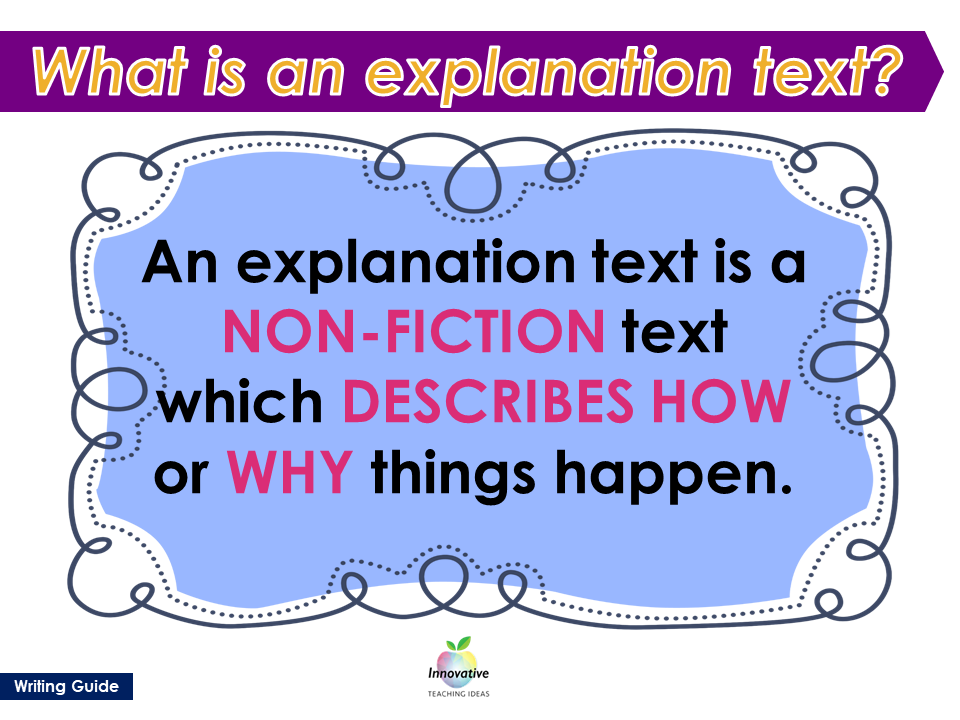•EXPLANATION TEXT•
WHAT IS AN EXPLANATION TEXT?

An explanation text tells your audience how something works or why something happens.
Explanations detail and logically describe the stages in a process, such as the water cycle, or how a steam engine works. Other examples could be how a law is made, or why we blink when we sneeze.
There are three types of explanations.
“Explanation texts are frequently incorporated into other texts, used to provide information which answers questions of interest on that topic”
Sequential – These detail the stages in an event eg: how a caterpillar turns into a moth.
Causal - Details what causes the change from one stage to the next ie: How a president is elected.
Theoretical - Details the possible phenomena behind a natural or created process that is not fully understood. eg What caused the Nazi's to lose World War II.
Factorial and consequential explanations explain effects and outcomes of processes. They are more commonly used in upper primary and secondary contexts. For example:
Scientific– eg Explain the causes of climate change (Factorial)
Historical– eg Explain the causes of World War 2 (Factorial)
DON'T GET CONFUSED BETWEEN EXPLANATION TEXTS AND PROCEDURAL TEXTS.

An explanation text is similar to a procedural text, and these can often be confused, however an explanation text explains the how and why behind a process such as
What causes a Tsunami?
Why are our rain forests disappearing?
The process of making aluminum.
A procedural text is generally instructs how to make or do something such as recipe. Although they appear similar they are very different when compared side by side.
EXPLORING THE STRUCTURE AND FEATURES OF EXPLANATION TEXTS









This HUGE BUNDLE offers a mix of hands-on, printable, and digital media resources. By the time you have finished this pack, your students won’t just be able to READ and COMPREHEND Explanations, but will also be WRITING their own with a high level of STRUCTURE, INSIGHT AND KNOWLEDGE.
😊Structure and Features of effective explanations
😊Writing Activities. (Both independent and group tasks)
😊Multiple Templates and Graphic Organizers
😊Video and Visual Explanatory writing prompts
😊Explanatory Writing Checklists
😊Assessment Rubrics plus MUCH MORE.
The entire collection is provided to you in EDITABLE PowerPoint and as a printable PDF eBook. Each lesson is a complete plan that eliminates your preparation time, but if you need to modify the content to suit a particular class, you can easily do so.
STRUCTURING YOUR WRITING TIME EFFECTIVELY
Using your writing time effectively is really crucial. When writing an explanation you will need to spend a significant period of time (Approximately 20 percent) researching your topic to ensure you know what you are talking about.
Next take an equal amount ( 20 percent) of time to structure your writing using a graphic organizer or mind map which can be found below.
If you follow this model you really only need to spend around 40 percent of your time writing. Your ideas and structure will already be formed.
This will leave you with around 20 percent editing and revising your essay for meaning, spelling and grammar and structure.
The use of graphic organizers, planning tools and writing checklists will greatly assist the planning and editing time.

WELL LABELLED IMAGES CAN SAVE YOU A GREAT DEAL OF EXPLAINING.
THE LANGUAGE FEATURES OF AN EXPLANATION TEXT ARE...
The use of technical terms such as evaporation, degradation if writing about the water cycle.
Action verbs and present tense such as runs, develops and becomes
Cause and effect terms such as because of.., due to.., therefore, and as a result
POINTS TO CONSIDER BEFORE WRITING
What is it about? What are you explaining? Are you explaining how or why something happens or are you explaining a process.
What is the title?
What are the important parts, section of what you want to explain? How would you describe it and its parts? Which parts need to be described as part of the explanation?
How does it work? What happens first, next and and why?
What else might you include?

No comments:
Post a Comment